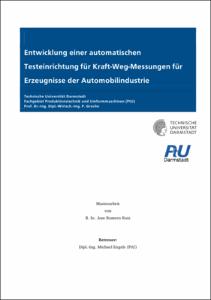Mostra el registre d'ítem simple
Development of an automatic test device for force and displacement measurements for automotive products
| dc.contributor | Engels, Michael |
| dc.contributor.author | Romero Ruiz, Jose |
| dc.date.accessioned | 2012-03-15T14:20:17Z |
| dc.date.available | 2012-03-15T14:20:17Z |
| dc.date.issued | 2010 |
| dc.identifier.uri | http://hdl.handle.net/2099.1/14793 |
| dc.description.abstract | Automotive infotainment systems are automotive equipment manufactured with narrow tolerances. Besides the hardware itself, the components that interact with the user and with the rest of the car have to fulfil strict requirements. These components are the buttons face plate and the pins connector. The buttons must fulfil haptics requirements of force and stroke in order that the feeling of pressing them would be the same as the rest car buttons’ feeling. The pins connector must fulfil force requirements in order that ergonomic and resistance characteristics would be achieved. These characteristics must be measured to verify whether the prototypes are within required tolerances in order to produce the infotainment system model. Developing a test device to check the force and stroke characteristics of infotainment systems is the aim of this project. Having its own forcestroke test device in the Panasonic headquarter in Langen would speed up the process of verification and modification of the infotainment systems prototypes and would simplify the design task. To develop the suitable test device required, the characteristics of both kind of test have been taken into account. The button test and the pins connector tests have very different requirements. On one hand, the button test requires high resolution, accuracy and repeatability and its range of force is from 0N to 10N. On the other hand, the pins connector tests require applying higher force, from -125N to 450N, being negative for pulling and positive for pushing. Moreover, these kinds of tests do not require sensors resolution and accuracy as high as those for the button test. Taking into account these requirements, a stable and stiff test device with an actuator, two force sensors and a displacement sensor has been developed. The simplicity of the device was a necessity due to the stability and the low cost required. Apart from the design and development of the test device, the application interface has also programmed, using LabVIEW software. The software for controlling and getting the result of the button test has already been developed and is totally functional. However, the software of the pins connector tests will be the next tasks to achieve. Although the repeatability of the test device is acceptable, its accuracy must be tested by a certification company, in order to validate the test device performance. To sum up, this test device has been a good inversion. Panasonic has got a low cost test device with which the company will save money, the infotainment systems will not be tested by an external company, and time, the test device will speed up the verification and modification process of prototypes. |
| dc.language.iso | eng |
| dc.publisher | Universitat Politècnica de Catalunya |
| dc.publisher | Technishe Universität Darmstadt |
| dc.subject | Àrees temàtiques de la UPC::Enginyeria mecànica::Disseny i construcció de vehicles::Automòbils |
| dc.subject.lcsh | Automobiles--Electronic equipment |
| dc.title | Development of an automatic test device for force and displacement measurements for automotive products |
| dc.type | Master thesis (pre-Bologna period) |
| dc.subject.lemac | Automòbils -- Equip electrònic |
| dc.rights.access | Open Access |
| dc.audience.educationlevel | Estudis de primer/segon cicle |
| dc.audience.mediator | Escola Tècnica Superior d'Enginyeria Industrial de Barcelona |
| dc.provenance | Aquest document conté originàriament altre material i/o programari no inclòs en aquest lloc web |
| dc.audience.degree | ENGINYERIA INDUSTRIAL (Pla 1994) |
| dc.description.mobility | Outgoing |


